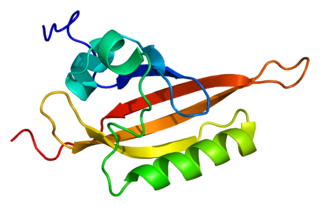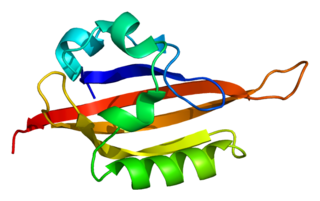
A basic helix–loop–helix (bHLH) is a protein structural motif that characterizes one of the largest families of dimerizing transcription factors. The word "basic" does not refer to complexity but to the chemistry of the motif because transcription factors in general contain basic amino acid residues in order to facilitate DNA binding.

The aryl hydrocarbon receptor is a protein that in humans is encoded by the AHR gene. The aryl hydrocarbon receptor is a transcription factor that regulates gene expression. It was originally thought to function primarily as a sensor of xenobiotic chemicals and also as the regulator of enzymes such as cytochrome P450s that metabolize these chemicals. The most notable of these xenobiotic chemicals are aromatic (aryl) hydrocarbons from which the receptor derives its name.

The ARNT gene encodes the aryl hydrocarbon receptor nuclear translocator protein that forms a complex with ligand-bound aryl hydrocarbon receptor (AhR), and is required for receptor function. The encoded protein has also been identified as the beta subunit of a heterodimeric transcription factor, hypoxia-inducible factor 1 (HIF1). A t(1;12)(q21;p13) translocation, which results in a TEL–ARNT fusion protein, is associated with acute myeloblastic leukemia. Three alternatively spliced variants encoding different isoforms have been described for this gene.

Neuronal PAS domain protein 2 (NPAS2) also known as member of PAS protein 4 (MOP4) is a transcription factor protein that in humans is encoded by the NPAS2 gene. NPAS2 is paralogous to CLOCK, and both are key proteins involved in the maintenance of circadian rhythms in mammals. In the brain, NPAS2 functions as a generator and maintainer of mammalian circadian rhythms. More specifically, NPAS2 is an activator of transcription and translation of core clock and clock-controlled genes through its role in a negative feedback loop in the suprachiasmatic nucleus (SCN), the brain region responsible for the control of circadian rhythms.

Aryl hydrocarbon receptor nuclear translocator-like 2, also known as Arntl2, Mop9, Bmal2, or Clif, is a gene.

Endothelial PAS domain-containing protein 1 is a protein that is encoded by the EPAS1 gene in mammals. It is a type of hypoxia-inducible factor, a group of transcription factors involved in the physiological response to oxygen concentration. The gene is active under hypoxic conditions. It is also important in the development of the heart, and for maintaining the catecholamine balance required for protection of the heart. Mutation often leads to neuroendocrine tumors.

DNA-binding protein inhibitor ID-1 is a protein that in humans is encoded by the ID1 gene.

DNA-binding protein inhibitor ID-3 is a protein that in humans is encoded by the ID3 gene.

Transcription factor HES1 is a protein that is encoded by the Hes1 gene, and is the mammalian homolog of the hairy gene in Drosophila. HES1 is one of the seven members of the Hes gene family (HES1-7). Hes genes code nuclear proteins that suppress transcription.

Single-minded homolog 2 is a protein that in humans is encoded by the SIM2 gene. It plays a major role in the development of the central nervous system midline as well as the construction of the face and head.

Achaete-scute homolog 1 is a protein that in humans is encoded by the ASCL1 gene. Because it was discovered subsequent to studies on its homolog in Drosophila, the Achaete-scute complex, it was originally named MASH-1 for mammalian achaete scute homolog-1.

Hairy/enhancer-of-split related with YRPW motif protein 2 (HEY2) also known as cardiovascular helix-loop-helix factor 1 (CHF1) is a protein that in humans is encoded by the HEY2 gene.

ID4 is a protein coding gene. In humans, it encodes for the protein known as DNA-binding protein inhibitor ID-4. This protein is known to be involved in the regulation of many cellular processes during both prenatal development and tumorigenesis. This is inclusive of embryonic cellular growth, senescence, cellular differentiation, apoptosis, and as an oncogene in angiogenesis.

Protein atonal homolog 1 is a protein that in humans is encoded by the ATOH1 gene.
Neurogenins, often abbreviated as Ngn, are a family of bHLH transcription factors involved in specifying neuronal differentiation. The family consisting of Neurogenin-1, Neurogenin-2, and Neurogenin-3, plays a fundamental role in specifying neural precursor cells and regulating the differentiation of neurons during embryonic development. It is one of many gene families related to the atonal gene in Drosophila. Other positive regulators of neuronal differentiation also expressed during early neural development include NeuroD and ASCL1.

Neurogenic differentiation factor 2 is a protein that in humans is encoded by the NEUROD2 gene.

Aryl hydrocarbon receptor nuclear translocator 2 is a protein that in humans is encoded by the ARNT2 gene.

MKL/myocardin-like protein 2 is a protein that in humans is encoded by the MKL2 gene.

Basic helix-loop-helix ARNT-like protein 1 or aryl hydrocarbon receptor nuclear translocator-like protein 1 (ARNTL), or brain and muscle ARNT-like 1 is a protein that in humans is encoded by the BMAL1 gene on chromosome 11, region p15.3. It's also known as MOP3, and, less commonly, bHLHe5, BMAL, BMAL1C, JAP3, PASD3, and TIC.

(HES7) or bHLHb37 is protein coding mammalian gene found on chromosome 17 in humans. HES7 is a member of the Hairy and Enhancer of Split families of Basic helix-loop-helix proteins. The gene product is a transcription factor and is expressed cyclically in the presomitic mesoderm as part of the Notch signalling pathway. HES7 is involved in the segmentation of somites from the presomitic mesoderm in vertebrates. The HES7 gene is self-regulated by a negative feedback loop in which the gene product can bind to its own promoter. This causes the gene to be expressed in an oscillatory manner. The HES7 protein also represses expression of Lunatic Fringe (LFNG) thereby both directly and indirectly regulating the Notch signalling pathway. Mutations in HES7 can result in deformities of the spine, ribs and heart. Spondylocostal dysostosis is a common disease caused by mutations in the HES7 gene. The inheritance pattern of Spondylocostal dysostosis is autosomal recessive.



















